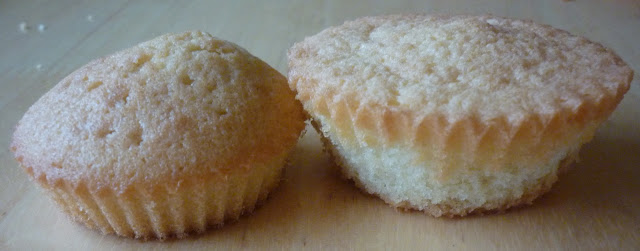Pound cake is not quite as light or fluffy as sponge cake - it's more dense and bready in texture, because the butter whipping method doesn't create quite as much air as the egg method. Which is why sponge cake is might lighter - eggs whip up to a much greater volume, meaning they've incorporated much more air, and so they rise more during cooking. Neither one cake is better than the other. The best one depends on the situation or occasion, your personal tastes, and a whole load of other factors. Of course I recommend you make them both at once in order to compare!
There's nothing much left to be said now, except to give you the overall run-down I like to do. Starting with sponge cake, for no real reason:
- Start with eggs. Obviously the amount you use will dictate the amount of finished cake you have. Ideally, you should weigh your eggs, because the weight can vary, but if you don't, then assume 1 egg weighs about 50g and go from there.
- Weigh in the sugar - the same weight as the eggs (or 50g per egg).
- Now whip it up, baby. Put it in an electric mixer, or use an electric whisk, and whip it until the eggs have almost tripled in volume. (Yes, I know, that's almost as annoying as the 'until doubled in size' rule for bread rising, but some people can cope with instructions like that). If you don't like the sound of that, whip them for three minutes or so, on a high setting, until it's increased in volume a lot, smooth and pale and lovely-looking. You'll figure it out, I managed it alright the first time round, so it's not as complicated as it sounds.
- Now, add the other ingredients. First, the flour - sift it first so it's not lumpy at all. Add the same weight of sifted flour as the eggs and sugar, and fold it in gently. 'Fold' just means stir it, but by gently turning it over, rather than aggressively knocking it around. The idea is, we don't want to lose all the lovely air bubbles we just made by whipping the eggs.
- Next the butter - weigh out the same amount of butter as all the other ingredients, and then melt it in the microwave (or on the hob if you're old-fashioned like that), then add it to the bowl and 'fold' in again
- Time to cook it. Have the oven on about 175C, maybe a bit less for a fan oven. Put the mixture into whatever container/s you're using. This will make whatever kind of cake you want really, round, loaf, cupcakes, it's up to you. All you need to do is take account of the size to think about the cooking time. If it's a large amount of mixture in a single tin, it could take 45 minutes or so. For mini cupcakes, it could be as little as 10. It's done when you can stick a toothpick or skewer in the middle and it comes out without any crumbs stuck to it.
- The end! Some people like to ice cakes. I don't think I've iced a cake in about eight years. Presumably I will get there eventually, but for now, if you want to ice it, I'm probably not the ideal source of information.
And now onto pound cake. It's similar, but slightly different, like we talked about:
- Start with butter. You want it to be soft-ish, but not melted. Take it out of the fridge long enough before starting that it's reached room temperature, or stick it in the microwave for 10 or 15 seconds, until it's softish. Whip it a little bit to break it up and smooth it out.
- Now add in the same weight of sugar, and it's time to get really whipping. Using an electric mixer or electric handheld whisk, whip it until it's nice and soft, smooth and fluffy. A few minutes should do, the same applies as sponge cake - I'm sure you'll get the hang of it, and I managed OK the first time. Don't expect the volume to increase anywhere near as much as it does for eggs though, because butter can only do so much.
- Next, add your eggs - use roughly one egg per 50g of the other ingredients. If you like, you could weigh the eggs as you put them in, and you might find they weigh a bit more or a bit less than you expect, and you end up adding one more or less egg than you predicted. But if you can't weigh as you go along, it doesn't matter. Add them one at a time and fold them in until they're fully blended before adding the next one.
- And finally the sifted flour - fold it in gently until the batter is just about smooth, don't mix it for any longer than is necessary.
- Have the oven on about 175C, and stick the mixture in whatever you're using. Pound cake is often made as a loaf, but it's up to you, I made mine in the shape of cupcakes and they were perfectly nice too. The cooking time will be variable based on the size and shape of your container/s, but will average at slightly longer than the cooking time for sponge cake.
- And you're done! Refer to the last point on sponge cakes for notes about icing (and my lack of knowledge thereof).
Here are some pictures to show the different results of my pound and sponge cupcakes :
Sponge
Pound
Size difference with the same amount of mixture (pound left, sponge right)










No comments:
Post a Comment